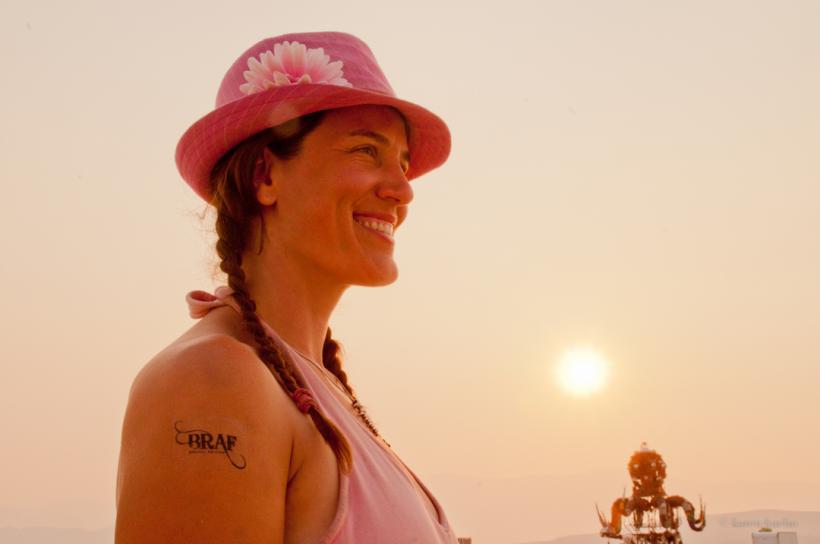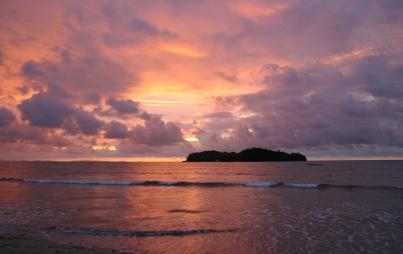
Jess Hobbs is one of the masterminds behind some of the most awesome large-scale public art that’s happened in the past decade. If you missed the Temple of Flux (Burning Man 2010), Zoa, The Serpent Mother or Hand of God, check out Soma, currently at Pier 14 in San Francisco.
As long-time artistic director of the Flaming Lotus Girls (think ladies welding in tutus) and current co-director of the Flux Foundation, a Bay Area artist collective anchored by the mission “building art through community. building community through art,” Hobbs has had numerous opportunities to unite people together for the express purpose of making big art.
Throughout each magnificent build, Hobbs’ goal has always been two-fold: to create stunning displays of human creativity and ingenuity while igniting and inspiring community engagement and involvement. Each piece includes interactive elements; participants have been able to shoot fire out of God’s hand and weave through the delicate chambers of the Temple of Flux. The creative and engineering output behind every project always includes the thoughts, ideas and contributions of hundreds of minds—and hands.
Hobbs and I recently sat down over tacos, and after just a few minutes of conversation it was clear that I had been granted access into the mind of a true maker and a dedicated believer in the power of community-fueled art.

Let's start at the beginning. What is a “maker," exactly?
Someone who has the desire and skill set to create a physical experience that encapsulates an idea. I think we used to be a country of makers. We used to be more connected to our hands and our tools, but we don’t grow up that way anymore.
Why have we lost these ways?
We’re not taught these ways in schools. You only memorize info and you’re keeping the right and left sides of the brain separate.
At Flux we call the intersection of the right and the left brains “makermind.” The two sides can often collaborate really well together.
How did Flux come to be?
Flux was born from recognizing a time and a place where all of our collective skills and experience were ripe to form an organization. A lot of us were already engaging in collaboration—art, music, etc. We discovered that gathering like this was a great way to create not only art, but also community and culture.
Flux is a nonprofit where the mission is to engage people through collaboration, learning, empowerment and leadership. Our primary focus is on the process of making. This means that we focus on the lab, the Petri dish that must exist for innovation to spring forth.
We operate from a platform of permission: Everyone involved has permission to explore his or her own creativity. And instead of being directors or leaders we like to use the title “vision holders.” We try to cultivate a horizontal leadership structure and also a parallel learning structure. Flux aims to help everyone understand that they are an artist.
That sounds idyllic, but how does a structure like that function in real life with real people?
Sometimes it’s messy. The structure leaves room for experimentation. And we treat mistakes as information. But our vision holders see the start point, end point and supporting points of a project and they keep a certain level of tension between them. Vision holders are project managers for the present and cheerleaders for the future.
What’s the idea generating process like for Flux?
We start by considering how much money we have to work with and what problem we’re trying to solve—creativity is a problem-solving strategy. We then make room for resonant ideas. Resonant ideas are ideas that often get multiplied—you have to pay attention to resonant ideas.
The idea generating process is really about letting go of your own ego and your attachment to your idea. Art comes from your experience in the world so it’s inherently personal, but when you’re working in collaboration that personal attachment doesn’t work.
It’s hard to get this work funded. People don’t always see what we do: that public art needs to be made by the public.
How would you define creativity? 
I don’t want to define it!
Is there a dream project for Flux?
There are the ego projects like doing something for P.S. 1 in New York City and the educational projects where we work more deeply with schools. But I’d really like San Francisco to give us the chance to create a city-wide creative laboratory.
What is it like being a woman who is comfortable building large-scale art pieces and lighting things on fire?
I grew up in a household with a dad who didn’t tell us "no" if we wanted to use a tool. He looked at us as intellectual beings. We had Barbies and Tonka trucks. Before I got my license I had to learn how to change my oil, change a tire, drive manual. I want the whole world to live up to that example and I often get frustrated because it doesn’t.
As artists and makers it still feels like women are pioneers and being a pioneer is a lot of work. I’ve had so many moments when a man is hovering above my right shoulder while I’m working. I can feel him thinking, “Just make a mistake so I can hop in and tell you what to do.”

How do we change things?
Pushing the edge isn’t for everyone. A girl who doesn’t have the pioneering drive isn’t going to pursue a career where she doesn’t see her gender reflected. We need to start with our classrooms and create more space for girls to take risks. Sometimes, simply raising your hand in class is a risk. We have to rethink our classrooms so girls have more room to explore what interests them. And “STEM” is missing a letter. It should be “STEAM.” The “A” is for art and creativity.
We also need to work on how we communicate our needs to men. You have to explain things calmly. You can’t be angry. You have to really believe that he doesn’t want to put you down—he’s just acting from learned behavior. Sometimes you have to stop what you’re doing and explain the situation, asking him, “Hey, can we take five minutes to talk?” And really work on clear articulation.
What role do you see Flux playing in the future?
There’s a lot about the way we work at Flux that I would like to see embraced by other organizations—businesses and educational facilities. Creativity may be the missing spark for many organizations. Overall, I’d like to see people given more space to play and explore their ideas. This would drive a more innovative culture.
Lead photo: Karen Keuhn






